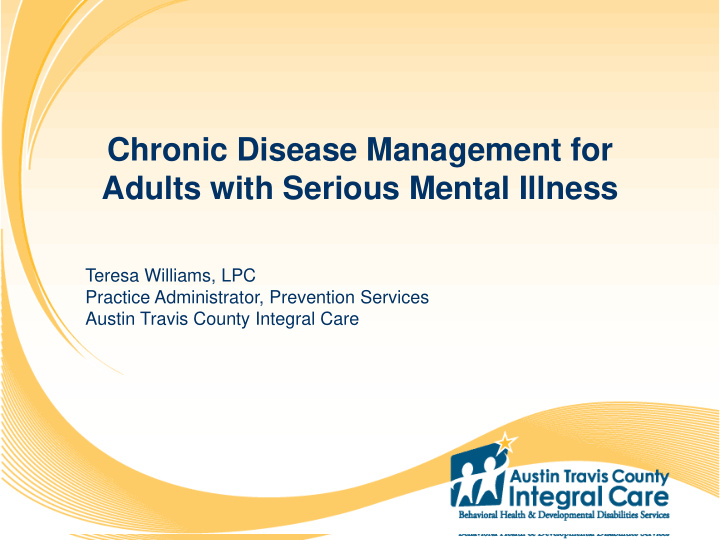



Chronic Disease Management for Adults with Serious Mental Illness Teresa Williams, LPC Practice Administrator, Prevention Services Austin Travis County Integral Care
Our Organization • Austin Travis County Integral Care provides community-based behavioral health and developmental l disabilities services in Travis County serving primarily low income and Medicaid recipients. • Funded through Federal, State and Local sources, Integral Care • Offers a range of services that emphasize the whole health of the individual. • Services include intake and assessment, crisis response, outpatient counseling, transitional housing, and many others designed to provide the best possible care,at the right time, in the right place.
An Integrated Care Model • 2009: E-Merge Program – behavioral health services in community medical clinics • 2011: Health Integration Project: medical services in behavioral health clinics • 2013: Chronic Disease Management Program – community supports for persons with serious mental illnesses (SMI) to self-regulate their chronic diseases • Integral Care programmatic development to address health disparities
25 Years of Life • Individuals with a mental illness live, on average, 25 years less than the general population – Poor/No access to healthcare – Higher rates of chronic diseases (70/40) – 50% more likely to be obese – Psychiatric medications CDC Vital Signs, Feb. 2013 Manderscheid and Colton, 2006 Mauer B., 2006
Tobacco Use Among People with Mental Illness • People with mental health (MH) and substance use disorder (SUD) diagnoses are consuming tobacco 2 to 3 times more than the rest of the population Shrestha L. CRS Report to Congress: Life Expectancy in the United States August 6, 2006 • The system in which they receive care traditionally does little to change tobacco use • The behavioral health system needs large systemic changes to address this problem • Tobacco control has to date largely ignored this issue
• The Chronic Disease Management Program is a voluntary program designed to assist and empower individuals with chronic disease conditions in the following areas: – Diabetes Management – Obesity Management – Tobacco Cessation – Physical Activity
Program Goals • Remove barriers • Provide support • Increase ability to self- manage chronic conditions • Improve health outcomes • Encourage independence • Make lifestyle changes • Celebrate success
Click here to hear consumers and staff’ testimonies
Exercise Management • InSHAPE (Self Health Action Plan for Empowerment) is a comprehensive program to improve health and longevity of people experiencing mental illness developed by Ken Jue at Monadnock Family Services • Studies have clinically significant improvements in cardiorespiratory fitness when participating in InSHAPE for one year. Clinically Significant Improved Fitness and Weight Loss Among Overweight Persons With Serious Mental Illness Stephen J. Bartels, M.D., M.S. Sarah I. Pratt, Ph.D., 2013
Initial Results – • Initial review of data (2014) drawn from electronic health records of individuals who have participated in a minimum of 40 CDM services shows this approach to be promising. – 86% showed improvement in blood pressure. – 70% show improved heart rates. – 75% have seen reduced waist measurement (average 1.5 inches) and – 80% have lost weight (average 11 pounds).
The below table includes all Chronic Disease Management recipients who received a service from July 25, 2013 through November 17, 2014. The Pre-CDM Admissions include any facility episodes that ended on July 24, 2012 through the day before the first CDM service. 3 of the 4 CDM IP Admissions occurring after te person received CDM services were for people who received fewer than 20 CDM services (2 of these received 1 service)
Individuals Enrolled Participating in 40+ Services *Currently in the process of analyzing data further
Recommend
More recommend